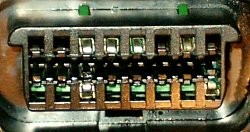Understanding whether your vehicle is OBD2 compliant is crucial for accessing valuable diagnostic information and ensuring your car meets modern emission standards. While most modern vehicles are, it’s not always obvious. It’s important to Check Vehicle For Obd2 Compliant status before using any scan tools or assuming compatibility. This guide will help you determine if your vehicle is OBD2 compliant, regardless of where it was manufactured, focusing on where it was originally sold.
Understanding OBD-II Compliance
OBD-II, or On-Board Diagnostics II, is a standardized system implemented in vehicles to monitor and report on various aspects of vehicle performance, including emissions. This standardization allows for universal diagnostic tools to communicate with any OBD-II compliant vehicle. The implementation of OBD-II was driven by environmental regulations, primarily aimed at reducing vehicle emissions. In the United States, legislation mandated OBD-II compliance for all cars and light trucks starting from the 1996 model year. Similar regulations followed in other regions, such as Europe (EOBD) and Japan (JOBD), although the implementation timelines varied. It’s important to note that OBD2 compliance is based on the regulations of the country where the vehicle was first sold, not where it was manufactured.
Quick Ways to Check for OBD-II Compliance
Several methods can help you quickly check vehicle for OBD2 compliant status.
Check the Vehicle Emission Control Information Label
One of the easiest ways to check is by locating the Vehicle Emission Control Information (VECI) label. This label is typically found under the hood of your vehicle, often on the underside of the hood itself or near the radiator.
Fig. 1 – Vehicle Emission Control Information Label: This label provides crucial information about your vehicle’s emission standards and OBD compliance.
Look for phrases like “OBD II compliant,” “OBD II certified,” “EOBD compliant,” or “JOBD compliant” on this label. The presence of any of these terms generally indicates that your vehicle is OBD2 compliant.
Consult Your Owner’s Manual
Your vehicle’s owner’s manual is another reliable source of information. Search for terms like “OBD,” “OBD-II,” “On-Board Diagnostics,” or “emission control system” in the manual’s index or table of contents. The manual should explicitly state whether your vehicle is OBD2 compliant and provide details about the diagnostic system.
Check the Diagnostic Link Connector (DLC)
Nearly all OBD-II compliant vehicles are equipped with a standardized 16-pin Diagnostic Link Connector (DLC). This connector is usually located within 2 feet of the steering wheel, often under the dashboard. While the presence of a 16-pin DLC is a good indicator, it’s not a guarantee of OBD-II compliance. Some pre-OBD-II vehicles also featured 16-pin connectors, particularly European and Asian models.
OBD-II Compliance by Region and Model Year
To provide a clearer picture, here’s a breakdown of OBD-II compliance based on the country where the vehicle was originally sold and the model year. Remember to check vehicle for obd2 compliant status based on these guidelines but always verify using the methods above.
- United States: All cars and light trucks sold in the United States from the 1996 model year onwards are mandated to be OBD-II compliant. This includes a wide range of manufacturers and models.
- European Union (Petrol Vehicles): Full OBD-II (EOBD) compliance was mandatory for petrol vehicles sold in the EU from 2001 (for all types) and 2000 (for new types). Limited compliance may be found in some 2001 models.
- European Union (Diesel Vehicles): For diesel vehicles in the EU, full EOBD compliance became mandatory from 2004 (for all types) and 2003 (for new types). Limited compliance may be present in certain 2004-2006 diesel models.
- Canada: Vehicles sold in Canada were generally OBD-II compliant from the 1998 model year onward.
- Other Countries: Compliance dates vary significantly for other countries. For example, Australia implemented OBD-II for petrol vehicles in 2006 and diesel in 2007. Brazil adopted OBD-II for petrol in 2007 and diesel in 2015. Many other countries have adopted OBD-II regulations in the 2010s and 2020s.
For a more detailed overview, refer to compatibility charts that list specific countries and model year ranges for OBD-II implementation. These charts can provide a general guideline, but always prioritize checking your vehicle’s label and manual.
The 16-Pin Connector: Not Always a Guarantee
It’s a common misconception that if your car has a 16-pin Diagnostic Link Connector (DLC), it is automatically OBD-II compliant. This is not always the case. Many manufacturers, especially in Europe and Asia, began using 16-pin connectors before fully implementing OBD-II systems. These pre-OBD-II connectors might look similar but lack the full functionality and standardized communication protocols of OBD-II.
One distinguishing feature sometimes found in non-EOBD compliant vehicles is a DLC that doesn’t fully conform to the SAE J1979 standard. As illustrated below, some connectors might have “ears” or slight variations compared to the standard J1962 connector used in OBD-II compliant vehicles.
Fig. 2 – Ford Escort DLC (non-EOBD compliant): Notice the “ears” on this pre-OBD-II connector, a feature not found on standard OBD-II connectors.
Fig. 3 – J1962 Vehicle Connector, Type A: This is the standard connector type for OBD-II compliant vehicles, characterized by its rectangular shape without “ears”.
While these visual differences can sometimes be subtle, they highlight that simply having a 16-pin connector is not definitive proof of OBD-II compliance. Always use a combination of the methods described above to accurately check vehicle for obd2 compliant status.
Conclusion
Determining if your vehicle is OBD2 compliant is essential before using scan tools for diagnostics or emission checks. While model year and country of sale provide helpful guidelines, the most reliable methods are checking the Vehicle Emission Control Information label and consulting your owner’s manual. Don’t solely rely on the presence of a 16-pin connector, as it’s not a foolproof indicator. By using these methods, you can confidently check vehicle for obd2 compliant status and ensure compatibility with OBD-II diagnostic equipment. If you remain unsure, consulting a trusted mechanic or your vehicle dealership is always a prudent step.

